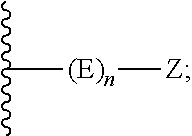Proteasome activity enhancing compounds
a proteasome and activity-enhancing technology, applied in the field of proteasome activity-enhancing compounds, can solve problems such as the presence of toxic protein aggregates, and achieve the effect of enhancing proteasome activity
- Summary
- Abstract
- Description
- Claims
- Application Information
AI Technical Summary
Benefits of technology
Problems solved by technology
Method used
Image
Examples
example 1-10
[0096]Cycloalkyl ketone I where Q is oxygen, sulfonyl (SO2) or nitrogen bearing a methyl, acetyl or carbamate protecting group is subjected to a Gewald Reaction with nitrile II, being either ethyl cyanoacetate where D is an ethyl ester group or cyanoacetamide where D is a carboxamide group, which affords product III. Typically the Gewald reaction is conducted in the presence of sulfur and an amine base such as triethylamine in an alcohol solvent such as ethanol at a temperature ranging from 0° C.-80° C. In the case where D in III is an ester, then E in IV is a nitrile and both agents are condensed under acidic conditions at temperatures ranging from 0° C.-50° C. to give product V, typically in a polar ether such as dioxane into which gaseous hydrogen chloride gas has been bubbled in. Alternatively, when D in III is a carboxamide, then E in IV is an ester and the condensation of both agents is conducted under basic conditions at temperatures ranging from 60° C.-100° C. to give produc...
example 1
Preparation of Compounds 1-10
[0142]Referring to Scheme 1 above, cycloalkyl ketone I where Q is oxygen, sulfonyl (SO2) or nitrogen bearing a methyl, acetyl or carbamate protecting group is subjected to a Gewald Reaction with nitrile II, being either ethyl cyanoacetate where D is an ethyl ester group or cyanoacetamide where D is a carboxamide group, which affords product III. Typically the Gewald reaction is conducted in the presence of sulfur and an amine base such as triethylamine in an alcohol solvent such as ethanol at a temperature ranging from 0° C.-80° C. In the case where D in III is an ester, then E in IV is a nitrile and both agents are condensed under acidic conditions at temperatures ranging from 0° C.-50° C. to give product V, typically in a polar ether such as dioxane into which gaseous hydrogen chloride gas has been bubbled in. Alternatively, when D in III is a carboxamide, then E in IV is an ester and the condensation of both agents is conducted under basic conditions ...
example 2
Preparation of N-cyclopropyl-N-methyl-6,8-dihydro-5H-thiopyrano[4′,3′:4,5]thieno[2,3-dlpyrimidin-4-amine (Compound 11)
[0144]
[0145]The POCl3 (1.3 ml, 13.37 mmol) was added dropwise to a stirred suspension of 3,5,6,8-tetrahydro-4H-thiopyrano[4′,3′:4,5]thieno[2,3-d]pyrimidin-4-one (300 mg, 1.34 mmol) in toluene (15 ml). The reaction mixture was heated at 100° C. for 18 hr, then cooled and concentrated under vacuum. Toluene (3×20 ml) was added, and the solvent removed under vacuum. The residue was slowly diluted with 5 ml H2O then poured into 5% NaHCO3 (100 ml) solution, and extracted with EtOAc (2×100 ml). The combined organic extracts were washed with H2O (1×20 ml), brine (1×20 ml), dried (MgSO4) and concentrated to give a solid. The crude was purified by chromatography on silica gel eluting with 35% EtOAc / Hexanes to give 215 mg of 4-chloro-6,8-dihydro-5H-thiopyrano[4′,3′:4,5]thieno[2,3-d]pyrimidine as an off white solid. 1H NMR (300 MHz, CDCl3) δ ppm=2.99-3.16 (m, 2H); 3.40-3.56 (m, ...
PUM
| Property | Measurement | Unit |
|---|---|---|
| temperatures | aaaaa | aaaaa |
| temperatures | aaaaa | aaaaa |
| temperatures | aaaaa | aaaaa |
Abstract
Description
Claims
Application Information
 Login to View More
Login to View More - R&D
- Intellectual Property
- Life Sciences
- Materials
- Tech Scout
- Unparalleled Data Quality
- Higher Quality Content
- 60% Fewer Hallucinations
Browse by: Latest US Patents, China's latest patents, Technical Efficacy Thesaurus, Application Domain, Technology Topic, Popular Technical Reports.
© 2025 PatSnap. All rights reserved.Legal|Privacy policy|Modern Slavery Act Transparency Statement|Sitemap|About US| Contact US: help@patsnap.com



